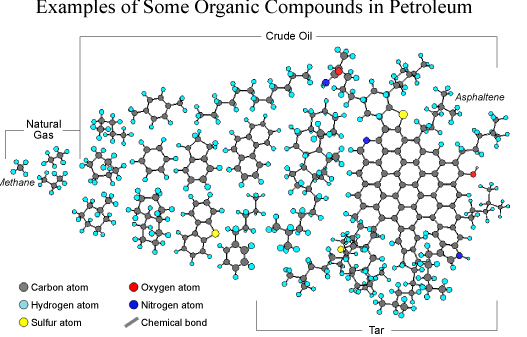托福分数测试HOT
托福课程优惠HOT
托福正价课试听0元
新托福机考练习NEW
0元讲座HOT
新版托福入门课程HOT
托福入门导学NEW
4000人报
托福机经
PDF版
TPO练习
官方授权
资料下载
826套
专业测评
40118人已测
高分经验
1193帖

扫码免费领资料
托福全科备考资料
免费水平测试及规划

扫码关注掌握一手留学资讯
回复XDF免费水平测试
本文是TPO 43 阅读背景资料!The origin of petroleum以及El Niño, Southern Oscillation。托福阅读材料推荐:地球化学研究是很好的托福阅读背景知识补充阅读材料。希望对大家托福备考有所帮助。更多精彩尽请关注新东方在线托福网!
Geochemistry Research
ORGANIC ORIGINS OF PETROLEUM
Petroleum is a naturally occurring substance consisting of organic compounds in the form of gas, liquid, or semisolid. Organic compounds are carbon molecules that are bound to hydrogen (e.g., hydrocarbons) and to a lesser extent sulfur, oxygen, or nitrogen. The simplest of these compounds is methane with one carbon atom bound to four hydrogen atoms (Figure 1). Asphaltenes are the most complex with more than 136 carbon atoms bound to more than 167 hydrogen atoms, 3 nitrogen atoms, 2 oxygen atoms, and 2 sulfur atoms (Figure 1). Petroleum gas is referred to as natural gas, which should not be confused with the abbreviated term used to describe the refined fuel "gasoline". Natural gas consists predominantly of simple hydrocarbons with only one to five carbon atoms (i.e., methane to pentane, respectively, Figure 1). Liquid petroleum is referred to as crude oil and consists of a wide range of more complex hydrocarbons and minor quantities of asphaltenes (Figure 1). Semisolid petroleum is tar, which is dominated by larger complex hydrocarbons and asphaltenes (Figure 1).

Figure 1. Some examples of organic compounds in petroleum, from the simplest (methane) to the most complex (asphaltene).
Petroleum formation takes place in sedimentary basins, which are areas where the Earth's crust subsides and sediments accumulate within the resulting depression. As the sedimentary basin continues to subside, sediment accumulations continue to fill the depression. This results in a thickening sequence of sediment layers in which the lower sediment layers eventually solidify into sedimentary rocks as they experience greater pressures and temperatures with burial depth. The sediment layers that accumulate vary in character because the sources and depositional settings of the sediments change through geologic time as the sedimentary basin subsides and fills. It is critical to petroleum formation that at some time during the accumulation of sediments at least one of the sediment layers contains the remains of deceased plants or microorganisms. Throughout geologic time, the world oceans have expanded and receded over the Earth’s land surfaces and contributed sediment layers to subsiding sedimentary basins. Development of stagnant water conditions in some of the expanded oceans caused the bottom waters to be depleted in oxygen (anoxic), which allowed portions of decaying plankton (e.g., algae, copepods, bacteria, and archaea) that originally lived in the upper oxygen-bearing (oxic) waters to be preserved as a sediment layer enriched in organic matter (Figure 2). Swamps and marshes may also develop marginal to oceans overlying subsiding basins. In these depositional settings, sediment layers enriched in decaying land plants (e.g., trees, shrubs, and grasses) may occur.

 资料下载
资料下载
2021-2025托福机经试题|答案|范文下载
发布时间:2024-02-21关注新东方在线托福
回复【XDF】获取
托福全科备考资料大礼包
发布时间:2024-02-21关注新东方在线托福
回复【XDF】获取
托福正价课试听课程包
发布时间:2024-02-21关注新东方在线托福
回复【XDF】获取
托福定制备考规划
发布时间:2024-02-21关注新东方在线托福
回复【XDF】获取
托福TPO免费模考
发布时间:2024-02-21关注新东方在线托福
回复【XDF】获取
托福免费水平测试
发布时间:2024-02-21关注新东方在线托福
回复【XDF】获取
托福写作新题型模拟题+范文汇总[ETS发布]
发布时间:2023-07-30关注新东方在线托福
回复【XDF】获取
2023全年托福机经PDF版下载
发布时间:2023-06-17关注新东方在线托福
回复【XDF】获取
2022全年托福机经PDF版下载
发布时间:2023-06-17关注新东方在线托福
回复【XDF】获取
2022全年写作托福机经整理
发布时间:2023-01-13关注新东方在线托福
回复【XDF】获取
2022年托福考后题目回忆
发布时间:2023-01-13关注新东方在线托福
回复【XDF】获取
托福口语黄金80题附录音
发布时间:2023-01-13关注新东方在线托福
回复【XDF】获取
新东方IBT写作网络课堂录音[.rar]
发布时间:2023-01-13关注新东方在线托福
回复【XDF】获取
21天托福听力提升计划
发布时间:2023-01-13关注新东方在线托福
回复【XDF】获取
不怕跑题偏题,这份写作资料请收好
发布时间:2023-01-13关注新东方在线托福
回复【XDF】获取
托福阅读提分技巧锦囊妙计
发布时间:2023-01-13关注新东方在线托福
回复【XDF】获取
口语拖后腿?因为你缺少这套万能句式资料
发布时间:2019-11-01关注新东方在线托福
回复【XDF】获取
攻破托福听力难关的资料包
发布时间:2023-01-13关注新东方在线托福
回复【XDF】获取
看剧学英语,经典美剧一键获取
发布时间:2019-11-01关注新东方在线托福
回复【XDF】获取
原版外刊资源合集|精心打包整理
发布时间:2019-11-01关注新东方在线托福
回复【XDF】获取

关注新东方在线托福,
回复【XDF】获取大礼包

 推荐阅读
推荐阅读
托福考试网整理了2024托福考试时间、托福考试内容、托福写作新题型样题+范文、托福考题等内容,今天带来的是ETS官方托福阅读模拟题【2】,希望对同学们托福考试有所帮助!
托福考试网整理了2024托福考试时间、托福考试内容、托福写作新题型样题+范文、托福考题等内容,今天带来的是ETS官方托福阅读模拟题【1】,希望对同学们托福考试有所帮助!
托福考试网为大家整理了2024年托福阅读评分标准、托福阅读考试时间、托福阅读备考攻略等内容,今天给大家带来的是2024年1月托福考试考前刷题:阅读题(4),供大家参考!
托福考试网为大家整理了2024年托福阅读评分标准、托福阅读考试时间、托福阅读备考攻略等内容,今天给大家带来的是2024年1月托福考试考前刷题:阅读题(3),供大家参考!
托福考试网为大家整理了2024年托福阅读评分标准、托福阅读考试时间、托福阅读备考攻略等内容,今天给大家带来的是2024年1月托福考试考前刷题:阅读题(2),供大家参考!



 资料下载
资料下载
关注新东方在线托福
回复【XDF】获取
关注新东方在线托福
回复【XDF】获取
关注新东方在线托福
回复【XDF】获取
关注新东方在线托福
回复【XDF】获取
关注新东方在线托福
回复【XDF】获取
关注新东方在线托福
回复【XDF】获取
关注新东方在线托福
回复【XDF】获取
关注新东方在线托福
回复【XDF】获取
关注新东方在线托福
回复【XDF】获取
关注新东方在线托福
回复【XDF】获取
关注新东方在线托福
回复【XDF】获取
关注新东方在线托福
回复【XDF】获取
关注新东方在线托福
回复【XDF】获取
关注新东方在线托福
回复【XDF】获取
关注新东方在线托福
回复【XDF】获取
关注新东方在线托福
回复【XDF】获取
关注新东方在线托福
回复【XDF】获取
关注新东方在线托福
回复【XDF】获取
关注新东方在线托福
回复【XDF】获取
关注新东方在线托福
回复【XDF】获取

 阅读排行榜
阅读排行榜
 相关内容
相关内容